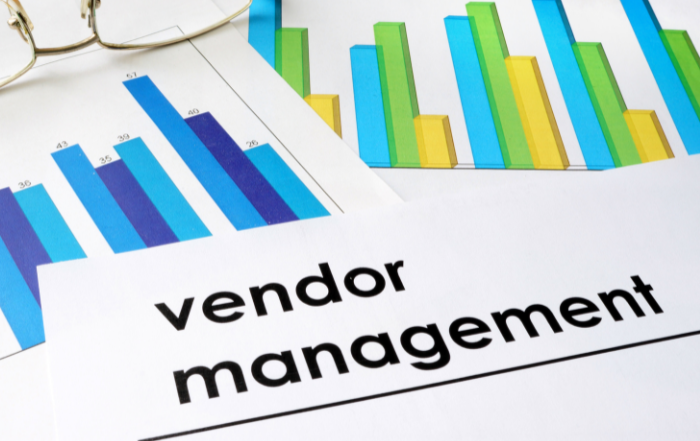The Ideal Purchase Order Approval Workflow in Salesforce
With the advent of information technology, the idea of cybersecurity didn’t even exist. It wasn’t until the ’60s that Fernando Corbato first presented the idea of password protection. Today, two-factor authentication is the industry standard. But why these extra steps?
These security measures are an inconvenience to their users, but what they cost in extra time, they more than make up for in integrity and reliability.
In the world of security, password protection is an extra step that restricts access so that only the right people can access resources. In the world of purchasing, purchase order approval is an extra step that restricts purchasing power so that only the right people can spend resources. While a purchase order approval workflow may require additional time and labor to process orders, it ensures that only authorized spenders can place orders and helps organizations keep track of inventory inflow and cash outflow.
Why Purchase Orders?
Purchase orders are legally binding documents issued by a buyer and given to a seller. Purchase orders protect both buyers and sellers. It assures buyers that they will receive the desired product and promises sellers that the buyer will pay the agreed-upon amount.
Not every organization is large enough to use purchase orders—smaller organizations that place orders infrequently or in small quantities don’t require purchase orders and can rely on the same organization systems as consumer purchasers. However, once an organization has grown to the point that the individuals responsible for requisition can’t easily keep track of purchasing activities off the top of their heads, purchase orders are necessary to document and authenticate purchases.

Purchase Order Approval Workflow
The workflow in organizations that don’t use purchase order approvals is straightforward: it places the order, receives the goods, and processes the invoice. While the traditional system is simple, it isn’t as effective or valuable for organizations.
The traditional purchasing approach doesn’t account for the needs of managing activities. A purchase order approval workflow allows managers to oversee the purchasing trends and procedures at a high level.
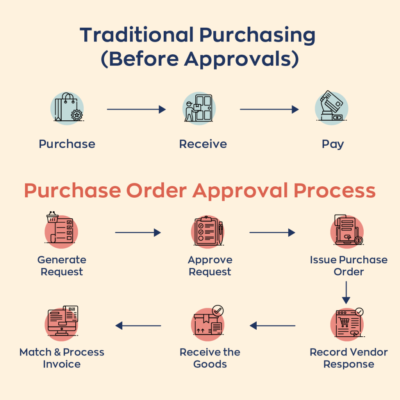
While there are many different workflows for approving purchase orders, the ideal workflow follows some general steps.
1. Generate Request
The buyer does not send this request to the seller but uses it internally to track purchasing activities. Unlike purchase orders, purchase requisitions are internal requests for permission to place an order. The traditional purchasing workflow doesn’t include purchase requisitions, so this step is unique to the purchase order approval workflow.
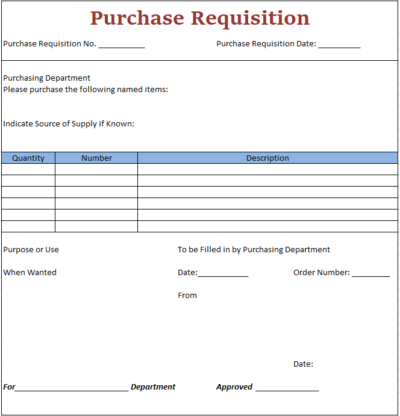
2. Approve Request
Once an employee issues a purchase requisition, their manager must approve their request. Think of this process as accessing a safety deposit box at a bank—first, the customer must request the key, then the bank personnel must approve their request, but the contents of their safety deposit box are not accessible until the customer puts the key to use.
At the approval stage of the purchase order approval workflow, the buyer has not yet placed an order but has approved the financial decision to place it. Salesforce designates certain users with the authority to approve purchase requisitions. This is an essential part of the purchase order approval workflow because it prevents exploits of the system and enforces the appropriate chain of authority over purchasing activities.
3. Issue Purchase Order
Once the buyer has generated and approved a purchase requisition, the employee can place the order. While the purchase requisition is an internal document, the buyer sends the purchase order to the seller. Purchase orders have unique identifying numbers so that organizations can track purchases for accounting and inventory purposes. A purchase order is not yet legally binding at this stage because only one party has agreed to it.
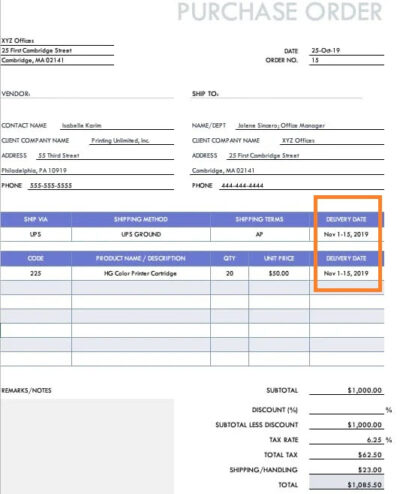
Salesforce makes the process of creating a purchase order simple. From the accounting page, click Create Entries, and then create a purchase order. This allows users to pull in saved vendor information to streamline their workflow and keep it as error-free as possible.
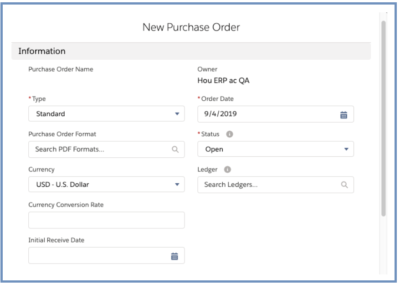
4. Record Vendor Response
Once the buyer has generated the purchase order and issued it to the seller, the seller must agree. At this point, the purchase order becomes legally binding. It’s important to record this response from the vendor so that the organization can accurately predict inventory and manage purchasing needs.
5. Receive Goods
Now that the seller has generated and approved the requisition order, issued the purchase order, and the vendor has acknowledged it, the buyer waits to receive the goods from the seller. Once the buyer receives the goods, the vendor issues an invoice to the buyer.
6. Match and Process Invoice
Once the buyer receives the invoice, the buyer matches the invoice number with the purchase order number (typically using accounting software). The reason purchase orders are so useful is because they allow organizations to keep track of their orders across time, so having a concrete purchase order number to tie to an invoice consolidates all the relevant information about an order into one location.
From here, the buyer pays the invoice according to the terms the seller offers. Usually, sellers will offer a discount for invoices paid within a specified period (such as 10, 30, or 60 days), so having an established procedure for processing purchase orders and invoices save companies money by keeping things on track.
Salesforce Functions
In previous years, the purchase order approval workflow was something businesspeople performed in person, by fax, or even by mail. However, modern technology has reframed the platforms businesses use to conduct these processes. Today, Salesforce is a leading CRM where business users can see everything from advertising automation to vendor contact info to e-commerce sales from one centralized location.
Because Salesforce is such an essential tool for businesses, it’s only natural that they would support purchase order approval workflow options.
Enable Purchase Order Approvals
One of the options Salesforce offers its users is a checkbox to see if PO has to be approved before sending it to the vendor. If the user checks this box, the system will lock the user out from submitting purchase orders until the organization generates and approves a purchase requisition. This helps mitigate the risk of users trying to bypass the system, but it also helps prevent human error from submitting purchase orders early by mistake.
Enable Purchase Order Filing
Similarly, Salesforce’s Enable Purchase Order Filing checkbox locks users out of closing purchase orders until they appropriately file the documentation. This is a safeguard to make sure users are documenting their purchases correctly so that the system can keep functioning as intended.
How Rainmaker Can Help
Salesforce is a powerful tool for modern businesses, but integrating with their cloud platform can be daunting.
That’s where Rainmaker can help. Rainmaker is an expert in Salesforce-managed services. They can help you integrate your organization with Salesforce’s advanced suite of products so that you can reap the benefits of a smooth purchase order approval workflow.
Take the guesswork out of your Salesforce integration by contacting Rainmaker today to schedule a meeting and see how they can help.

